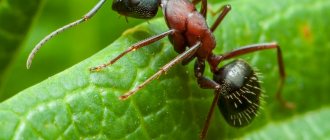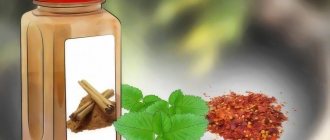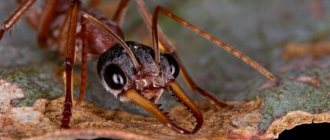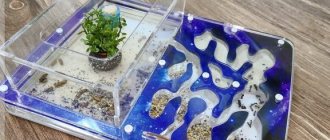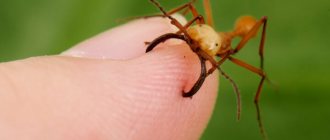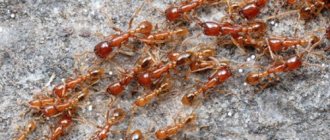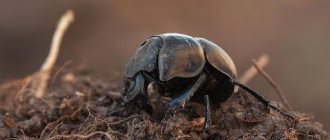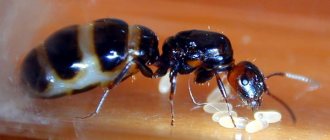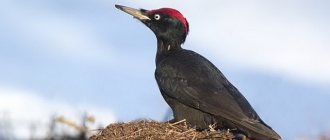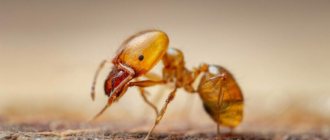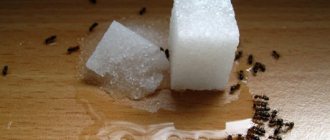Bulldog ants live in Australia. Scientific name: myrmecia gulosa. There are 90 types of bulldogs, the most common being black and red. The bites of these insects are dangerous for humans due to severe allergies, including anaphylactic shock. The pain after the bite lasts for several days and is accompanied by fever and general weakness. According to some data, more people die from bulldog bites than from spiders, snakes, and deadly sharks.
Description of appearance
Everyone knows what an ordinary ant looks like. These creatures have a similar structure, but the shape of the head and body is slightly different.
Long multi-toothed mandibles, bulging large eyes. The body size reaches 4 cm. The color is bright - red, red, and also glossy black. Possessors of a strong sting with dangerous poison. Used for self-defense, as well as when attacking a victim. Paralyzes in an instant. The antennae are straight, slightly longer in females.
Bulldog ants differ from other ants in the special structure of their hind legs. Insects can jump well, which allows them to wait for prey in a secluded place and easily attack at the right moment. One jump reaches a length of 50 cm. Photos of the unique creatures are presented below. You can clearly see the structural features of the body.
Interesting!
Bulldogs are the largest ants in the world. However, the queen differs from the working individuals only slightly – by only 5 mm. In one family there are several young females that quickly take the place of the queen after death.
Bulldog Ants
The red bulldog ant differs from its black relative in its bright red color. This coloring is a warning sign - it is deadly. Externally, the ant resembles a wasp without wings.
general characteristics
The insects got their name due to the unique structure of their jaws.
The ability to capture and hold prey, to attack and defend itself is ensured precisely by barbs of varying lengths. It is not possible for the victim to escape from such an “embrace.” Moreover, due to the work of their jaws, insects are able to make jumps: up to forty centimeters in length and up to eight in height. This helps them avoid becoming easy prey for lizards and other food seekers.
Bulldog ants can easily be considered the largest: their length can reach four centimeters. In terms of external structure, they resemble wasps without wings; large eyes increase the similarity. A powerful poisonous sting is also one of the distinguishing features of these huge insects.
A working bulldog ant can lift 50 times its own weight . Dragging a large cockroach to the habitat of the larvae does not cause any difficulties for the insect.
One of the most dangerous species is the black bulldog ant. They are territorial insects and fight not only with representatives of other colonies, but also with each other. Anthills are mounds up to 60 centimeters high or hidden deep under stones. They move mainly by jumping.
Despite their belligerence, bull ants (another name for bulldogs) are unusually hardworking. In addition to getting food, they are forced to dig deep passages deep into the earth. The insects' habitat is the arid regions of Australia. For the development of larvae, moistened layers of soil are required, which is why anthills go far down into the underground floors. Although the internal structure of the home is quite simple and primitive.
The number of species of bulldog ants reaches ninety, the most common of which are red ones. All of them are dangerous to humans; the poison is synthesized on a protein basis and has a strong effect.
Interesting fact . Bull ants are able to swim across water obstacles up to 15 centimeters wide. And some of them can talk - there are notches on their backs that cause a characteristic crackling sound, even more audible than that of cicadas.
Anthill
The black bulldog ant digs the ground well, and the red one is not inferior in these abilities. Anthills are built at a depth of 3 meters from the surface. This feature of the architectural structure is easily explained by the arid climate of Australia. Larvae need moisture.
The inside of the nest is primitive, much inferior to the house of the ants living on our territory. A colony is rarely numerous. Numbers several thousand individuals. Other species reproduce into the millions.
Symptoms of a bite
When attacking, the insect uses both fangs and a sting. When a sting is used, a toxic substance enters the body through it. It is impossible not to feel it; they are quite painful, since they do not have pain-relieving enzymes. Swelling and redness immediately appears on the skin.
When an allergy occurs, a person feels severe weakness and a headache appears. Also, a person’s blood pressure drops sharply and their heartbeat fluctuates. Dense inflammatory foci appear at the site of the bite. The limbs and larynx begin to swell.
If a person is bitten by a bulldog ant, first aid must be provided immediately. It is necessary to treat the wound with any alcohol solution; it is mandatory to take antihistamines if a person has allergies. Unfortunately, for a child, the bite is much more dangerous, as it causes immediate swelling and respiratory arrest.
If you like to travel, for walks in tropical areas, you will need the help of local residents. They know very well what they look like and what places to avoid. The danger is great enough that there is no risk.
Nutritional Features
Adults suck the juices of plants, berries, and fruits, but obtain protein food for the voracious larvae. They attack other insects, fearlessly fight wasps and spiders, and quite often win.
Interesting!
Bulldog ants do not know how to transfer undigested food to larvae, but they lay white eggs. They save the colony in times of famine.
Bulldogs are characterized by parasitism. The female climbs into the home of other ant species, mercilessly kills the queen, and takes her place. The enslaved ants are forced to feed her offspring and herself. Over time, the colony of bulldogs grows and gradually eats smaller relatives.
Bulldog Ant Habitat
Habitat
As already mentioned, they are inhabitants of Australia, since it is here that there are ideal conditions in which they can live and reproduce normally. They build their anthills underground, and their passages go deep down.
The fact is that in this way they provide themselves with the necessary level of humidity, since they cannot tolerate drought. Regarding the number of colonies, they can vary significantly, some consist of 100 individuals, and some reach 1000.
Reproduction
A female bulldog mates only once and reproduces eggs throughout her life. Unlike other ant families, an anthill has several fertile females that help replenish the colony. They live peacefully with the queen in the same house, without claiming her place.
Mating of young males and females occurs on the fly. By the time of mating season, insects develop wings. After mating, the males die within a few days, the females burrow into the ground to lay eggs and choose a place for the future anthill. Over many years, the queen does not grow to enormous sizes and differs only slightly from her relatives.
How do bulldog ants reproduce?
Mature flight occurs once a year. After mating, the males die, and the fertilized females look for a suitable place to create a new nest. Interestingly, the female is fertilized only once in her life, and then stores the sperm in her body and gradually uses it for new oviposition.
In the built nest, the female sheds her wings and lays the first batch of eggs. They produce working individuals who will act as nannies for subsequent offspring. After 2 years, the queen lays eggs, which differ in the set of chromosomes - males emerge from unfertilized eggs, and females emerge from fertilized eggs. When the young animals reach sexual maturity, a new breeding cycle begins.
Danger
Bulldog ants do not approach a person's home. But people, finding themselves in the possession of these insects, risk receiving numerous painful bites. The scout ant gives a signal to other relatives, they rush en masse to attack the enemy. For children, bites are especially dangerous and can lead to death if medical care is not provided promptly. Therefore, this species is often called killer ants.
Bulldogs continue to be studied, local Australian newspapers write about them, publish interesting facts, insect remains are found in excavations that date back 100 million years ago. More recently, 4 more species of myrmecia gulosa have been discovered. We can say that there are 94 of them.
Lifestyle
Bulldog ants inhabit regions covered with dense forest. They build nests in well-lit clearings. Each colony of bulldog ants consists of 500-1000 individuals. At the head of the colony is the queen. The body of bulldog ants is long (20-25 millimeters), elegant with a thin waist and high limbs. With their help, they easily pursue prey. The body of bulldog ants is covered with short hairs. Their distinctive feature is long, powerful mandibles with serrations on the inside.
Habitat
Black and red bulldog ants (Myrmecia gulosa) live in Australia. To survive, they create underground anthills, the labyrinths of which go down. Insects prefer moist soil for normal reproduction. The Australian tropics have the necessary humidity and moderate aridity for the normal existence of this type of ant. A large number of insects live on the territory of the island. Tasmania.
Red bulldog ant
The bull ant is still found on the islands of New Caledonia. Tropical humidity allows insects to create colonies consisting of 100-1000 individuals. This ant species was introduced to New Zealand.
Paraponera clavata
Bullet ant (24 hours) - they got this name because of their very painful bites, the pain from which does not subside throughout the day. When they bite, they release venom that paralyzes the site of injury.
Let's look at the main characteristics:
- They live in Central and South America in tropical areas;
- They differ in brown, brown, red-brown color; males have a lighter body shade;
- Families consist of a queen queen, male workers and soldiers;
- The body length of the female is up to 30 millimeters, the male is no more than 25;
- Families are small in size - approximately 1 thousand individuals, in rare cases it can reach up to 3 thousand;
- They eat small insects, tree sap, nectar;
- This is not an aggressive species, despite their poisonous bites - they will not attack first, warning the enemy with hissing and an unpleasant odor. The painfulness of a sting on the Schmidt scale is 4, for a better understanding – a simultaneous sting by 20 bees.
Ecology
Predators. They have small colonies of several hundred individuals (in some species up to several thousand). They nest in the ground (one species is arboreal). Young females independently establish new colonies. They have gamergates, that is, working individuals capable of mating and laying eggs after the loss of the uterus. Social parasites ( Myrmecia inquilina)
).
Myrmecia families
small in number, rarely exceeding 200 ants on average.
However, the more new data biologists accumulate, the more variations in this parameter are observed. According to Gray (1971; 1974), who examined 56 nests of 20 species of Myrmecia
, the average number is several hundred ants, with a maximum of more than 1000 workers found during excavations of anthills of such species as
Myrmecia nigrocincta
,
Myrmecia pyriformis
and
Myrmecia tarsuta
, and 2284 workers in
Myrmecia gulosa
.
The species Myrmecia brevinoda
has large anthills in the form of mounds up to 70 in height (from plant debris and soil), containing up to 2576 workers and 1 queen (this is the largest colony of ants of this genus found in Queensland, Higashi & Peeters 1990).
Oligomyrmex
,
Mayriella abstinens
,
Monomorium
,
Sphinctomyrmex
and
Pheidole
), termites and larvae of various insects were also found in uninhabited parts
Literature
- Bolton Barry. (). A new general catalog of the ants of the world
. — Harvard University Press, Cambridge, MA. — 504 pp. - Clark, John. (). The Formicidae of Australia.
Vol. 1. Subfamily Myrmeciinae. — CSIRO, Melbourne. - 1951. - 230 pp. - Gokhman Vladimir E.
Karyotypes of Parasitic Hymenoptera. - Dordrecht, Netherlands: Springer Science & Business Media, 2009. - ISBN 978-1-4020-9807-9. - Hölldobler Bert, Wilson Edward O.
The Ants. - Cambridge, Massachusetts: Belknap Press of Harvard University Press, 1990. - ISBN 0-674-04075-9. - Ogata, Kazuo.
Ants of the genus Myrmecia Fabricius: a review of the species groups and their phylogenetic relationships (English) // Systematic Entomology: Journal. - 1991. - Vol. 16. - P. 353-381.
A few more important facts
These insects not only have a primitive structure, but also demonstrate an archaic way of organizing a colony. Usually the number of individuals in a colony does not exceed 2000. As a rule, these insects make their nests under a large stone, which can warm up, providing a constant, unfluctuating temperature in the anthill. Such anthills allow these ancient ants to survive cool nights without losing their young.
For a long time, bulldog ants did not settle near human dwellings, but changing climatic conditions forced them to settle closer to people, where it was possible to find a place to build a nest with a constantly maintained temperature. Currently, cases of bulldog ants settling near human dwellings are extremely rare, but similar facts exist.
Such a neighborhood is extremely unfavorable for humans. These insects are aggressive and will attack any creature that passes by their nest. Considering that these ants are armed with powerful pincers and stingers and have a small amount of poison, which they inject into the body of the victim. Despite the fact that the bite and venom of bulldog ants themselves cause an extremely painful reaction in humans, in most cases they are harmless. It is worth noting that the danger of bites lies in the development of an allergic reaction, which can lead to anaphylactic shock.
Notes
- Brown, William (1953). "Revisionary notes on the ant genus Myrmecia
of Australia".
Bulletin of the Museum of Comparative Zoology, Harvard University 111
(6): 1–35. - Johnson, Norman F.
[osuc.biosci.ohio-state.edu/hymDB/nomenclator.name_entry?text_entry=Myrmecia+pilosula&Submit=Submit
Myrmecia pilosula
Smith].
Hymenoptera Name Server version 1.5
. Columbus, Ohio, USA: Ohio State University (19 December 2007). Retrieved April 1, 2022. - Striganova B. R., Zakharov A. A.
Five-language dictionary of animal names: Insects (Latin-Russian-English-German-French) / Ed. Doctor of Biology sciences, prof. B. R. Striganova. - M.: RUSSO, 2000. - P. 293. - 1060 copies. — ISBN 5-88721-162-8. - Brown, Simon G. A. (2001). “[www.mja.com.au/public/issues/175_12_171201/brown/brown.html Fatal anaphylaxis following jack jumper ant sting in southern Tasmania].” Medical Journal of Australia 175
(11): 644–647. PMID 11837875. - Matuszek, M. A., Hodgson, W. C., Sutherland, S. K., King, R. G. (1992). Pharmacological studies of jumper ant Myrmecia pilosula venom: evidence for the presence of histamine and haemolytic and eicosanoid-releasing factors. Toxicon. 9: 1081—1091
- Street, M.D., Donovan, G.R., Baldo, B.A., Sutherland, S. (1994). Immediate allergic reactions to Myrmecia ant stings: immuniochemical analysis of Myrmecia venoms. Clin. Exper. Allergy. 24: 590—597
- [science.discovery.com/tv-schedules/special.html?paid=48.13784.23608.0.0 Discovery Channel: Killer Ants
] - Brown, S. G. A., Franks, R. W., Baldo, B. A., Heddle, R. J. (2003). Prevalence, severity, and natural history of jack jumper ant venom allergy in Tasmania. Journal of Allergy and Clinical Immunology. 111: 187–192
- ↑ 1 2 Steve Shattuck and Natalie Barnett,.
[anic.ento.csiro.au/ants/biota_details.aspx?BiotaID=37534 Myrmecia pilosula Smith, 1858] (English).
Ants Down Under
. Copyright 2005-2011 CSIRO Australia (www.Anic.ento.csiro.au) (2011). Retrieved July 20, 2011. [www.webcitation.org/67fGygris Archived from the original on May 15, 2012]. - Richard Harris & Jo Berry.
[www.landcareresearch.co.nz/research/biocons/invertebrates/Ants/invasive_ants/documents/15.pdf Myrmecia pilosula (Smith)] (English).
Information Sheet, Number 15
(unavailable link -
history
). Biosecurity New Zealand (www.Landcareresearch.co.nz). Retrieved 20 July 2011. [web.archive.org/20100518113839/www.landcareresearch.co.nz/research/biocons/invertebrates/Ants/invasive_ants/documents/15.pdf Archived from the original on 18 May 2010]. - A. Lima de Faria “Praise of the “stupidity” of the chromosome,” M.: BINOM. Knowledge Laboratory, 2012, P. 209, ISBN 978-5-9963-0148-5
Pest distribution areas
Every second person considers ants to be extremely harmless and beneficial, because they eat weak insects and destroy the bodies of dead living beings. But black ants bring not only benefits to the site:
- they grow aphids, which draw juices from plants;
- spoil the lawn;
- harm the roots and leaves of plants, gnaw edible root vegetables and sweet berries, spreading their acid to them;
- They spread bacteria that stick to their paws throughout the area, infecting plants and soil.
Domestic black ants are also dangerous:
- bring pathogenic bacteria from places where garbage accumulates, toilets and technical premises into the apartment;
- spoil food;
- they store food throughout the house, which spoils over time, which creates conditions for the appearance of mold fungi;
- They collect unnecessary garbage, excrement and food scraps outside their home, but on the territory of the apartment.
If you suddenly see even one insect, immediately begin getting rid of unnecessary neighbors.
Red ants are native to India and were once brought to Europe on merchant ships. In the cooler climate zone of Russia, insects create their colonies only where it is warm all year round - in human homes. This type of ant does not hibernate, so it is not able to survive the winter in natural conditions.
Thanks to their small size, a huge family of ants can fit into a shallow crevice
It is not at all difficult for nimble miniature insects to get into a house: cracks in the floor and walls are like a main entrance for them. Red ants do not build anthills. They settle in secluded, hard-to-reach places in the apartment, where they feel completely safe:
- in any cracks and cracks in the finishing;
- in cavities behind baseboards, peeling wallpaper, peeling linoleum;
- under kitchen cabinets, refrigerator;
- inside household appliances.
Literature
- Crosland, M. W. J. (1988). Effect of a gregarine parasite on the color of Myrmecia pilosula (Hymenoptera: Formicidae). Annals of the Entomological Society of America. 81: 481–484.
- Davies, N. W., Wiese, M. D., Brown, S. G. A. (2004). Characterization of major peptides in 'jack jumper' ant venom by mass spectrometry. Toxicon. 43: 173–183.
- Ford, S. A., Baldo, B. A., Weiner, J., Sutherlands, S. (1991). Identification of jack-jumper ant (Myrmecia pilosula) venom allergens. Clin. Exper. Allergy. 21: 167–171.
- Hirai, H., Yamamoto, M.-T., Ogura, K., Satta, Y., Yamada, M., Taylor, R. W., Imai, H. T. (1994). Multiplication of 28S rDNA and NOR activity in chormosome evolution among ants of the Myrmecia pilosula species complex. Chromosoma (Berlin). 103: 171–178.
- Ogata, K.
Ants of the genus Myrmecia Fabricius: a review of the species groups and their phylogenetic relationships (English) // Systematic Entomology. - 1991. - Vol. 16. - P. 353–381. - Ogata, K. and R. W. Taylor.
Ants of the genus Myrmecia Fabricius: a preliminary review and key to the named species (English) // Journal of Natural History. - 1991. - Vol. 25. - P. 1623–1673. - Williams, M. A. (1991). Insecticidal control of Myrmecia pilosula F. Smith (Hymenoptera: Formicidae). Journal of the Australian Entomological Society. 30: 93-94.
- Hölldobler, Bert & Wilson, Edward O. (1990), The Ants
, Cambridge, Massachusetts: Belknap Press of Harvard University Press, ISBN 0-674-04075-9 - Smith, Frederick.
Catalog of hymenopterous insects in the collection of the British Museum part VI. - London: British Museum, 1858.
Phylogeny
Genetic evidence suggests that the genus Myrmecia
diverged from other closely related groups of ants about 100 million years ago.
The subfamily Myrmeciinae was discovered in fossil form about 110 million years ago. According to other data, the age of the most modern common ancestor of the genera Myrmecia
and
Nothomyrmecia
is about 74 million years.
The closest non-ant living relatives of Myrmecia
are found among the Vespoidea wasps.
The following cladogram has been proposed showing the phylogenetic relationships within the genus Myrmecia
:
| Myrmecia | |
Classification
The species Myrmecia pilosula was first described in 1858 by the English entomologist Frederick Smith ( F. Smith
) in his major work
Catalog of hymenopterous insects in the collection of the British Museum part VI
based on materials from Hobart (Tasmania).
Smith described a worker, a female and a male. kept in the British Museum in London. In 1922, American entomologist William Morton Wheeler established the subgenus Halmamyrmecia
, characterizing its members' jumping behavior, and designated Myrmecia pilosula as the type species.
However, myrmecologist John Clarke later synonymized Halmamyrmecia
with the subgenus
Promyrmecia
(this occurred in a 1927 publication) and placed the species in that subgenus in 1943.
American myrmecologist William Brown synonymized Promyrmecia
due to the lack of strong morphological evidence distinguishing it from all other members of the genus
Myrmecia
and later included the species directly within the genus in 1953.
The specific name M. pilosula comes from the Latin word pilose
(covered with hairs).
The black bulldog ant is part of the Myrmecia pilosula
species complex, first described as a group by the Italian myrmecologist Carlo Emery.
This complex is a monophyletic group of morphologically similar taxa, but genetically distant from each other. This group includes the taxa M. apicalis
,
M. chasei
,
M. chrysogaster
,
M. croslandi
,
M. cydista
,
M. dispar
,
M. elegans
,
M. harderi
,
M. ludlowi
,
M. michaelseni
,
M. occidentalis M Queenslandica
,
M. rugosa
and
M. varians
.
In 2015, new species in this group were described, such as M. banksi
,
M. haskinsorum
,
M. imaii
and
M. impaternata
.
One of the synonyms of this species is Ponera ruginoda
(aka
Myrmecia ruginoda
) was described by Smith in the same work, and the male holotype was originally described for this synonym.
Ponera ruginoda
was originally included in the genera
Ectatomma
and
Rhytidoponera
, but was later classified as a junior synonym after comparison of the type specimens.
Emblem
Reconstruction of the Endeavor on which Myrmecia gulosa
arrived in London.
Ant Myrmecia gulosa
is the emblem of the Australian Entomological Society. This choice is due both to its noticeable "biting behavior" and to the fact that it was one of the very first insect species collected and scientifically described from Australia. First specimen of Myrmecia gulosa
(Fabricius, 1775) was collected at New Holland by naturalist Joseph Banks in 1770 during James Cook's first expedition.
This ant, along with other early Australian insects (the weevil Chrysolopus spectabilis
, a butterfly and two flies), was transported to Europe on the ship Endeavor at the end of the expedition.
This first ant is currently preserved in good condition in the Joseph Banks Collection
(Natural History Museum, London).
Fabricius, visiting this museum once again, discovered a new species for science in this worker ant, and a few years later he isolated it into a separate genus Myrmecia
.
Dinoponera
The genus includes six subspecies, each of which lives in the forests of Peru and Brazil.
Among the main features are:
- The dinosaur has a length of up to 32 millimeters, and the size does not depend on one gender or another;
- Their nests are clay flat mounds with burrows up to three centimeters in diameter. In most cases, anthills are located at the roots and trunks of trees, going deeper into the ground by more than 100 centimeters;
- Families are small, numbering up to several dozen;
- These are predatory arthropods that eat insects, amphibians, birds, and fish. Hunting is carried out at night; during an attack, the victim is subdued by stabbing;
- If they sense a threat, individuals run away, hiding in burrows;
- They bite painfully, but the bite is not dangerous to humans, the pain goes away after 15 minutes;
- Families have several working females, while laying eggs is carried out by only one of them - the one that secretes a pheromone that can suppress the will of each member of the colony.
What types of ants are there and what is their role in nature?
Despite the beneficial ecological and agricultural characteristics of ants, they can still cause harm to humans by settling in human housing. Of the large number of varieties of ants, you should know about the most dangerous to humans, which live in nature and whose poisonous bites can be fatal for sensitive people.
Ant family
Despite the different types of ants, all of them do not live as separate individuals, but build a common house - an anthill, within which they multiply their population. In each of these ant colonies, the ants are divided into groups that perform a specific task.
The colonial way of life of these insects contributes to the subsequent division of one anthill into several others. They often build their homes deep in the soil, in rotten wood, under small rocks, and can also settle in the foundation of a house, under floors, in external cracks in walls.
The most dangerous ants
Dangerous ants are often called killer ants. Killer ants are not fiction, but scientific proof of the existence of such insects that can lead to death in humans; allergy sufferers are more at risk. But this does not mean that other people may not suffer from their bites.
Poisonous ant populations include the following varieties:
There are legends among people that the most dangerous ants are cannibals. However, this is just a myth. Ants don't eat people. Their dangerous species can bite a person, and due to many bites and a large amount of ant poison, he can die. Small children are at risk of being bitten by hordes of ants.
